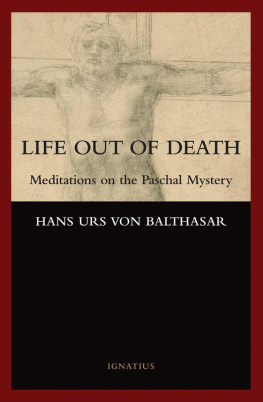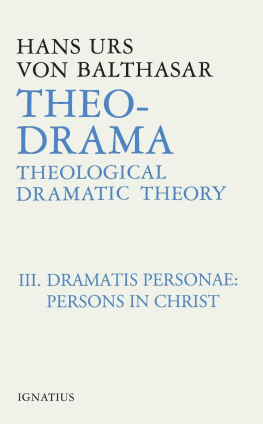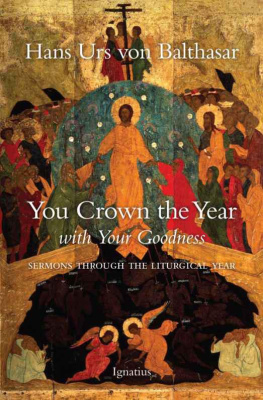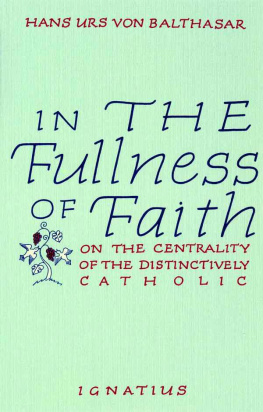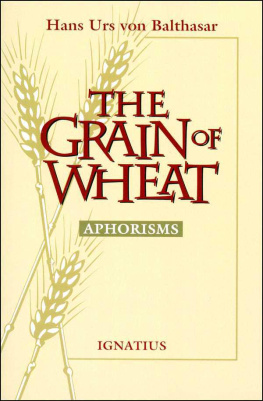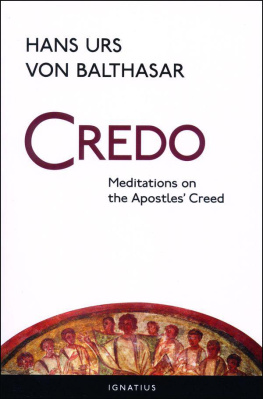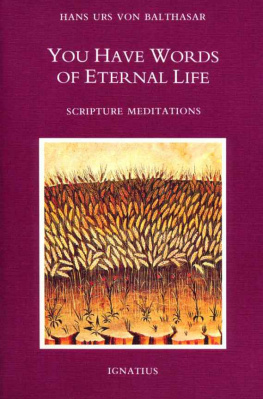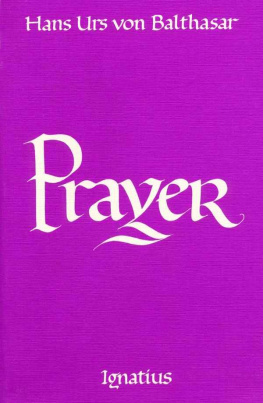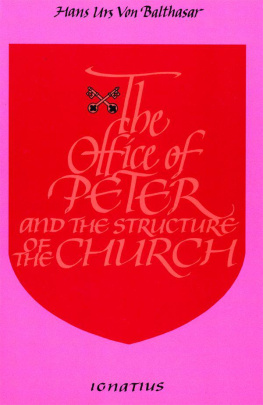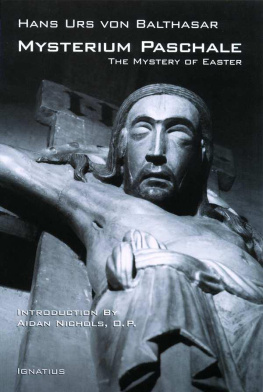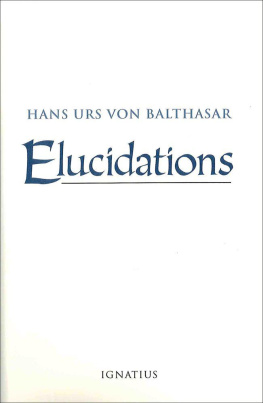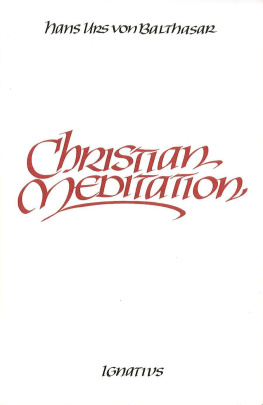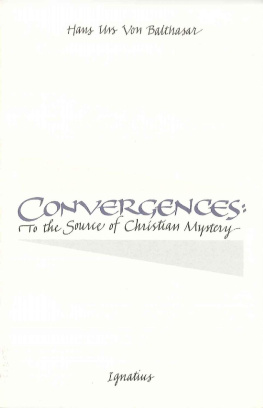LIFE OUT OF DEATH
HANS URS VON BALTHASAR
LIFE OUT OF DEATH
Meditations on the Paschal Mystery
Translated by Martina Stockl
IGNATIUS PRESS SAN FRANCISCO
Original German edition:
Leben aus dem Tod: Betrachtungen zum Ostermysterium
Third edition, 1997 by Johannes Verlag,
Einsiedeln, Freiburg im Breisgau
Cover art:
Study for Christ on the Cross , (black chalk)
by Michelangelo Buonarroti (1475-1564)
Louvre, Paris, France
Reunion des Musees Nationaux / Art Resource, New York
Cover designed by Roxanne Mei Lum
2012 by Ignatius Press, San Francisco
All rights reserved
ISBN 978-1-58617-144-5
Library of Congress Control Number 2011930606
Printed in the United States of America
CONTENTS
I
Life into Death
Dying is the most ordinary thingnewspapers list pages and pages of obituary and funeral notices to which no unaffected person pays any attentionand yet in an individual case it is the most incomprehensible thing because it crushes the little bit of meaning that has been arduously gathered in a lifetime and disperses it to the four winds. Where the death of a valued and beloved person makes its presence felt, all meaning of his life is put in brackets by it; the validity of this meaning is not definitive but is fragmentary at best. We see islands of meaning in an infinite sea of meaninglessness. And the view beyond is barred to us, all peeking behind the curtain, all guessworkspiritism, the teaching of reincarnation, and whatever else men might contrivewill not reveal the mystery. Even less so materialism; extending the chain of these fragments of meaning into the future in the hope that it may someday become something whole is more than utopian. We have to content ourselves with the fragmentary, but does this not contain a contradiction: that we know of something like meaning but are unable to trace the line of it?
First we need to deal with this contradiction that is inherent in all human existence and appears to be irreconcilable from a purely human perspective. But if Christianity presents itself as the salvation for man, we need to hear what solution it offers to thisin the endunbearable contradiction. We will do this in a concluding third point. In between, in the middle part, however, an attempt will be made to find something in human existence to which the Christian solution can refer, for if there were nothing, we would not see how what is Christian could connect to our existence at all. This starting point, admittedly, will become fully visible and effective only when what is Christian itself becomes evident; otherwise, it remains open to dangerous misinterpretations.
1. EXISTENCE IN CONTRADICTION
The little child opens wide eyes at the world. What he seesforms, colors, sounds...he does not comprehend. The phenomena are neither familiar nor strange to him because he cannot yet apply them to himself. His self is not yet disclosed to him; whatever consciousness he possesses lies halfway between subject and object. Now this is the true miracle among all these miracles of the beginning: that one day the mothers smile is recognized by the child as a sign of his acceptance in the world and that the center of his own self is disclosed to him as he returns the smile. He finds himself because he has been found. And because a You has found him, all the He that also surrounds him can be included in the relationship of familiarity. This is true for all the years the child grows up in the security of the family; whenever something strange is added, it is, if possible, included in the sphere of the familiar; otherwise, it is ignored. Nature and spirit are together in harmony.
Puberty brings a first questioning of this harmony. For the first time, the maturing person realizes his uniqueness as a person and thus experiences a loneliness hitherto unknown. He knows himself to be raised above the purely natural; he is not merely a specimen of a genus like the animals. And with the discovery of his uniqueness, an as yet undefined dreamlike horizon of a meaningful whole that would correspond to his person-hood presents itself to the young person. But what develops at the same time is his sexual maturity, which introduces him to the life cycle of the genus.
The first experiences of love will be the unconscious effort to connect both; the thrilling side of the experience will at first cover up the contradiction that will, however, show all the more glaringly in the disillusionments that necessarily follow. The disillusioned one feels himself betrayed not only by his partner but, on a deeper level, by his own nature. His nature demands from himand will not cease to do so throughout his lifethat he inscribe something permanent onto the surface of a transitory material.
The experience becomes acute when a young person asks himself what he will want to achieve in his lifetime. This is a question that an artist, for instance, experiences the most consciously and thus with the most torment; but an artisan, a farmer, or a merchant also feels some of it. Man wants to create something permanent, something above time, to make a definitive statement that would be the expression of his personal uniqueness. Of course, at times, one also has to do something purely transitory, like decorating a room for a feast. And one can put something of ones personality into such a thing, too. But the longing in man goes farther; no one wants to inscribe on pure transitoriness the work by which he tries to express himself fully; rather, a form should be molded that no time and no power will break up. Still he knows that everything earthly is drawn on the sand of transitoriness. Irretrievable masterpieces, if we look just at the history of art, have been destroyed forever. Let us gather some of the great losses: almost everything by Sappho, by Aeschylus and Sophocles; in music, many operas by Monteverdi, over twenty opuses by Bach, Schuberts Gastein Symphony; in art, all Greek painting, quite a lot of Romanesque painting, Leonardos Last Supper and Gozzolis Pisan frescoes during the last World War, which also claimed German Romantics; in architecture, how many ruinsfrom Borobudur to Cluny, how much that has collapsed in earthquakes, how much where only an eerie effect is left, like the Parthenon or the great Sphinx.
Peoples that understood they were building for their gods could clear away what was destroyed because they realized they could build something better; and they did, too. We have grown poor in this respect, and thus we simply restore, we cover destroyed Gothic vaults with concrete as long as we have the money. In the East there is already a very limited availability of funds. Which, of course, does not mean that the artists of our time do not wish to say a single valid word, just like their predecessors; it is only harder for them because the works of technology geared toward the purpose of the day claim so much of contemporary mans mental inventive and creative energy that it becomes more difficult to make oneself heard and seen over that. But great works of art even in our time prove that those who create have not lost the courage to fight against transitoriness.
Besides art, another contradiction in human existence needs to be remembered; we mentioned its emergence in young love. It becomes striking in marriage, where marriage is still taken seriously. Two people decide to belong to each other for life, but they do this in view of an eternity, for they want to love each other definitively. For life does not mean at all: I want to love you as long as you are alive, after that I will be free again. They mean the contradiction of something permanent within the limits of time. One of the two will die before the other. And it is always a painful paradox when, out of love, the dying one releases the survivor: You will marry again, wont you, otherwise, youll be so lonely...
Next page
